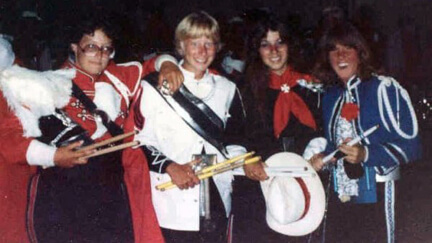Republished from the 2019 edition of the Drum Corps International Souvenir Yearbook.
When you name your band Chicks With Sticks, you’re making a statement. But years before they formed their celebrated percussion quartet, 1980s DCI alumni Gisèle Cadieux (Crossmen), Mary Gromko-Murray (Freelancers), Peggy Sue Snyder-Casey (Phantom Regiment), and Kelley Houpt (Blue Devils) just wanted to play percussion at the same level as young men their own age.
Today, many DCI percussionists and fans look back on them as trailblazers. At the time, they and fellow female percussionists were more likely to be seen as trespassers—girls encroaching on what was, then, almost exclusively, boys’ territory.
As Houpt recalls, though they weren’t the first women to play in co-ed drum corps groups, it was so rare to see another female drummer that she had to grab her camera. “In 1982 we were all on the field [after the Finals] with our given drum corps,” she says. “I was fascinated that there were other women snare drummers on the field and I only knew one of them, Mary Gromko-Murray. I had my camera with me and proceeded to approach each corps that I knew of that had women snare drummers. I wanted to meet them! So we snapped the picture of all of us at retreat, minus the gal in Spirit of Atlanta, Carla Azar, who was unable to leave formation.”

Though they’re still outnumbered, more women are playing percussion (and brass) in drum corps groups than ever before. “The number of females in marching percussion is definitely growing,” says Snyder-Casey, who currently balances roles as a band director, drum line instructor, mom, and percussion and brass performer. “Young women don’t seem to need encouragement to do so. When I was marching, it was definitely difficult to have the opportunity to play battery percussion. It was an ‘old boys club’ — and, at first, most were not happy to have me there at all. But once they understood that, one, I was going to work my butt off to be awesome, two, that I didn’t want to stand out as being a female in the line—just be a great player—and three, I didn’t want to change the culture of the line, they were ultimately accepting … after most of the first season was over.”
“Up until 1983 or 1984, women were not allowed in the Santa Clara Vanguard horn and drum lines,” Houpt adds. “Therefore, my focus became Blue Devils and, unlike [the other members of Chicks with Sticks] I had no problem with entering the Blue Devils’ all-male drum line.”
Opening eyes and ears

Today, it would be hard to find a drum corps director or caption head who’d say girls need to prove they can carry the drum sticks. Attitudes about gender roles in music, however, are more complex than simply acknowledging that women and men are equally capable of playing any instrument. In professional orchestras, studies have found that women fared better in blind auditions—even when the judges were also women.
It’s hard to do a blind audition in marching music. And decades ago, some felt that those who wanted to play drums could do so—as long as they didn’t do so next to men.
“I started in an all-girl drum corps and learned to play the snare drum there, but many co-ed groups would not even audition female drummers — no matter how awesomely she may have played,” Cadieux recalls. “It was very discouraging for aspiring female drummers. The boys were not all accepting and it was a real challenge for me to prove that I belonged.”
“I also started in an all-girl corps line, and when I went to 27th Lancers, they let me try, but it was hesitant”, Gromko-Murray says. “And I was definitely not treated well.”
As young children, girls and boys have traditionally been steered toward certain instruments and away from others. Over time, this leads to an imbalance in both performers and teachers.
“There was an obvious hole in female-directed and female-centered percussion education,” says Raychel Taylor, who marched as a member of the Mandarins, Phantom Regiment, and Santa Clara Vanguard between 2008-2011. “Where are the women teaching percussion? Where are all the girls on drum lines? They’re out there, we just aren’t seeing them together in the same places.”
Taylor, who continues to perform, created a program called Girls March to give girls and young female percussionists a place to develop their skills. Other Girls March instructors include Sandi Rennick (Santa Clara Vanguard) and Troopers percussion caption head Lauren Teel.
“We need a space for women in percussion, especially marching percussion,” Taylor says. “The idea isn’t original by any means, the summer camp model is widespread, but I feel strongly about my responsibility to the percussion community to contribute something positive and unifying.”
“There is another group affiliated with the Crystal Lake Strikers, an adult drum line that also has ‘training’ drum lines, in a Chicago suburb. It’s called Girls On The Drum and it’s run by Erin Arnold,” Snyder-Casey says. “I love it because it takes local girls who don’t have any drumming experience and they learn drumming in a fun, non-threatening environment. Many of the girls move on to play in competitive lines.”
More than music

On the DCI level, getting an opportunity to perform isn’t just about getting to play your desired instrument in front of fans. Spending a summer in a percussion or brass section teaches important life skills that can’t be learned in any other setting.
“I played in the front ensemble throughout my four years of drum corps and loved every second of it,” Taylor says, “It was a thrill to work toward a common goal with musicians who cared as much as I did—something that was definitely absent in my high school experience. I learned how to practice, I developed my ability to focus for long periods of time, I learned how to listen and be an excellent chamber music and ensemble player. My technique was always improving. The crazy drum corps schedule taught me flexibility and patience, and I was put into high-pressure situations where I was expected to perform well—and I did. I am forever grateful for what I learned from drum corps, it is one of the biggest reasons I am doing what I am doing in my career today.”
Are the trend lines moving toward a more even gender balance in percussion? “This is a difficult question to answer because everyone has different experiences,” says Taylor. “But in general — I think yes. There were two girls on my high school drum line, there were lots of girls on the drum line at Mandarins.” However, says Taylor, “Here is another pattern many female percussionists also observe: There are lots of girls playing percussion in middle school, some girls in high school, some women in Open Class or Semifinalist World Class drum lines, and almost no women in Top 12 drum lines. As competition increases, less women seem to earn fewer spots.”
“I’m seeing some growth in the number of females playing marching battery, especially in indoor programs,” agrees Cadieux. “Unfortunately, the progress seems to be slower in the summer DCI programs. It may be because of the higher intensity and physical demand of those programs but it is still considered somewhat extraordinary to see females playing snare or quads in drum corps, especially in the top ranks.
“The more they’ll see ladies out on the floor or the field playing, the more encouraged girls will be to learn!” Cadieux adds. “I find that the culture in terms of acceptance and opportunities for female drummers has changed tremendously. There is a sense of respect for female battery players amongst the boys lines and there are no longer any restrictions on auditions.”
According to Taylor, progress has been faster in some areas of the percussion section than in others. “It is fairly common to see girls in the front ensemble and on bass lines—especially top bass,” she explains. “On the other hand, there are [fewer] women on tenor lines. There are women on snare lines as well, but there can be an unspoken hierarchy within percussion sections—like the snare line is the most important, followed by the tenor line, and then the bass line. It doesn’t make a lot of sense, considering each section serves a different purpose and they all pose vastly different challenges, but that’s the way it is. This may be why it is more difficult for a girl to earn a spot on the snare line versus the bass line. This hierarchy even exists in the front ensembles: The more mature groups have an understanding that everyone is important, so the hierarchy is not as pervasive.”
According to Taylor, directors and instructors are becoming more receptive to handing girls mallets and drumsticks. “This is a conversation that is happening more openly and frequently, so directors are more aware that there can be implicit biases in placements,” she says. “Almost any woman who marched in a DCI corps before 2000 had to fight some kind of ‘women don’t play drums stereotype.’ This attitude still exists, and some women are still fighting it. But fewer women are confronted with that phrase as blatantly as in the past. More people accept that there should never be an instrument labeled as more ‘feminine’ or ‘masculine.’ Anyone can play anything with the right education and work ethic.”
“There are many inspiring women out there doing amazing work,” Taylor says. “I wrote a research paper in college about the International Sweethearts of Rhythm. They really opened doors for women in music, especially jazz. I learned about Terri Lyne Carrington during that time as well. Chicks With Sticks consists of some of the first women to ever march in Top-12 DCI drum lines and they still play together today.”
“I am so happy to see more women enter the world of drumming and wow, they are good!” Houpt says. “We were good in our day; there’s just a different approach to style and musicianship these days. There were women before us, in the early 1970s and even in the ’60s. I’ve been in contact with a few of them of late—they led the way!”
And thanks to those pioneers, today’s generation is no longer surprised to see other women share their passion for percussion. “I think if there is any difference at the moment, it’s the awareness of the current female players [through] social media,” says Troopers percussion caption head Lauren Teel. “Perhaps this will help motivate a cultural shift to where gender isn’t a noteworthy conversation in the drum line setting anymore.”






